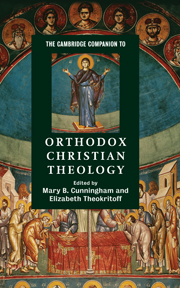Book contents
- Frontmatter
- Who are the Orthodox Christians? A historical introduction
- Part I Doctrine and Tradition
- 1 Scripture and tradition in the Church
- 2 Biblical interpretation in worship
- 3 God in Trinity
- 4 Creator and creation
- 5 The human person as image and likeness of God
- 6 Christ and salvation
- 7 Eschatology
- 8 The Church
- 9 Theology of the icon
- 10 The spiritual way
- Part II Contemporary Orthodox Theology: its Formation and Character
- Glossary
- Bibliography
- Index
- Series list
5 - The human person as image and likeness of God
from Part I - Doctrine and Tradition
Published online by Cambridge University Press: 28 March 2009
- Frontmatter
- Who are the Orthodox Christians? A historical introduction
- Part I Doctrine and Tradition
- 1 Scripture and tradition in the Church
- 2 Biblical interpretation in worship
- 3 God in Trinity
- 4 Creator and creation
- 5 The human person as image and likeness of God
- 6 Christ and salvation
- 7 Eschatology
- 8 The Church
- 9 Theology of the icon
- 10 The spiritual way
- Part II Contemporary Orthodox Theology: its Formation and Character
- Glossary
- Bibliography
- Index
- Series list
Summary
Who am I? What does it mean that I am human? Everybody asks these searching questions, but what is the Orthodox Church's answer? Orthodox reflection on what it is to be human begins with Genesis 1:26, 'Then God said, “Let us make man in our image, after our likeness”.' Theological anthropology, that is the study of humanity in the presence of God, begins by asking what it is about each human person that manifests the divine image and likeness. First of all, the Fathers usually distinguish between the image and likeness. The image names those Godlike characteristics with which we began, such as rationality, free choice, perception and the capacity to develop an excellent character. These characteristics form the foundation of our human existence. By choosing to use them wisely, we can then acquire the divine likeness, namely perception of and communion with God, actualisation of all the virtues, and eternal life. Though the two concepts are inseparable, the image is static and the likeness is dynamic: we can become more and more like God over time.
Theological anthropology begins from the first three chapters of Genesis. People today wonder what the historical value of these stories is, given that science tells us another narrative about human origins. Yet when Orthodox theologians have read Genesis 1-3 they have looked for answers to questions about humanity here and now, not about our ancient ancestors. These biblical stories tell us who we are in relationship to God and the natural world around us. By depicting Paradise they tell us what our life is supposed to have been like and what we can hope to become; by depicting the Fall they tell us where we went wrong and what our life has in fact become.
- Type
- Chapter
- Information
- The Cambridge Companion to Orthodox Christian Theology , pp. 78 - 92Publisher: Cambridge University PressPrint publication year: 2008
- 2
- Cited by



